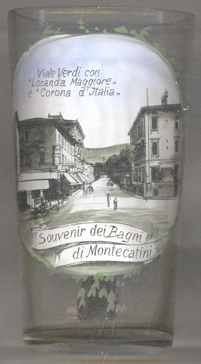

|
| ITALIA | ITALY |
| regione: Toscana | Sardinia |
| provincia: Pistoia |
 Montecatini Terme is situated at an elevaton of about 29 m in the provice Pistoia of the Italian region Toscana,
about halfway between Florence and Viareggio. The municipality has a population of about 1,200 and also includes the
village of Montecatini Alto (elevation 260 m) which is connected to Montecatini Terme be Italy's oldest still operating
funicular.
Montecatini Terme is situated at an elevaton of about 29 m in the provice Pistoia of the Italian region Toscana,
about halfway between Florence and Viareggio. The municipality has a population of about 1,200 and also includes the
village of Montecatini Alto (elevation 260 m) which is connected to Montecatini Terme be Italy's oldest still operating
funicular.
The existence of Montecatini Castello, today’s Montecatini Alto, was already documented in medieval times. In the settlement there was already a spa, thanks to the mineral waters of the place. Evidence for this comes from a document dating from 1340 which refers to the extraction of salt from the water. In Medieval times, the place was the site of numerous battles between the cities of Florence, Pisa and Lucca. From the 10th century until 1270 with the Republic of Lucca, attempts were made to dry up the marshy land; however, these works were never completely successful. From 1339 the Valdinievole region was under the dominion of the Medici in Florence. In 1529, the owner of the baths of Montecatini offered them to Cosimo Medici (Duke in 1532, Grand Duke in 1569). Although Cosimo's wife frequently visited Montecatini, the offer was not accepted, and thus Montecatini was again offered in 1538 to Francesco I, son of Cosimo, under the condition that the citizens of Montecatini would still be allowed to use the baths. When the Medici became extinct in 1737, Tuscany in 1738 came in possession of Habsburg-Lorraine. In 1765, Pietro Leopoldo, son of the Austrian ruler Archduchess Maria Theresia, assumed the title of Grand Duke of Tuscany (Holy Roman Emperor 1790–1792 as Leopold II). During this period, the channeling of the mineral waters and the restoration of the city began. In 1817 the Bagni di Montecatini passed to the community which also received the funds to keep them efficient. In 1905 Montecatini Alto and Bagni di Montecatini became autonomous municipal entities. In 1928 the name Bagni di Montecatini was changed to Montecatini Terme. In 1928 the municipality of Montecatini, together with all the other municipalities of the Valdinievole, passed from the province of Lucca to the newly formed province of Pistoia. In 2021, Montecatini Terme was listed by UNESCO as a World Cultural Heritage site (see list) as one of the "Great Spas of Europe", together with Baden (Austria), Spa (Belgium), Františkovy Lázně, Karlovy Vary and Mariánské Lázné (Czech Republic), Bad Ems, Bad Kissingen and Baden-Baden (Germany), and Bath (United Kingdom).
Glass no. 3640 [left] shows a view of  Viale Verdi
Viale Verdi Corona d'Italia
Corona d'Italia Locanda Maggiore
Locanda Maggiore

[https://de.wikipedia.org/wiki/Montecatini_Terme, https://de.wikipedia.org/wiki/Montecatini_Alto,
https://en.wikipedia.org/wiki/Montecatini_Terme]
![[scale]](lineal.jpg)